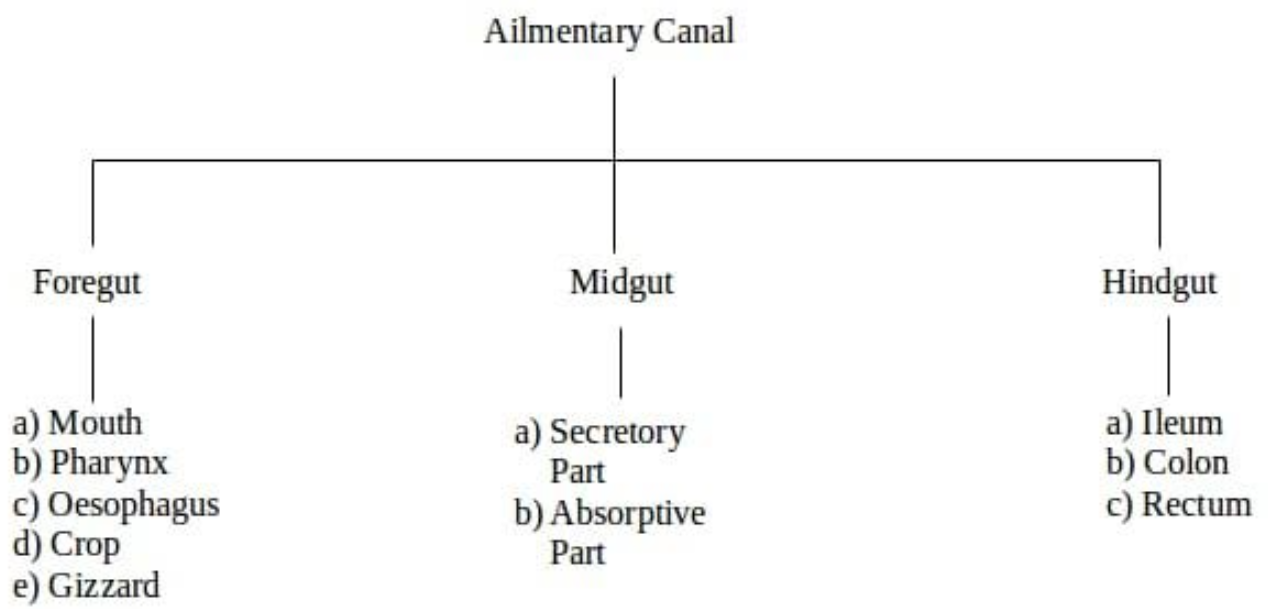
Describe the digestive system of cockroach.
Answer
412.7k+ views
Hint: The digestive system of cockroach consists of two parts i.e., alimentary canal and associated glands.
Complete Answer:
Cockroaches are omnivorous in nature and can eat all kinds of organic food sources available to them.
Parts of alimentary canal:
Alimentary canal is elongated & coiled. It starts from the mouth and ends with anus.

The alimentary canal of cockroach is divided into three regions: foregut, midgut, and hindgut.
1. Foregut: It consists of a mouth which is followed by a short tubular pharynx. The pharynx leads into a narrow and short tube known as oesophagus which in turn opens into a sac like structure called crop. Crop is used for storing food. The crop is followed by a gizzard. It has six teeth. Gizzard helps in grinding food particles.
2. Midgut or mesenteron: It is the middle part of the alimentary canal. Gastric or hepatic caeca (ring of 6-8 blind tubular structure) secret digestive juices that are present at the junction of foregut and midgut. Malpighian tubules (yellow color thin filamentous ring of 100-150) help in removal of excretory products present at the junction of midgut and hindgut. Mesenteron is the main site of enzyme production, digestion and absorption.
3. Hindgut: The hindgut is differentiated into: a. Ileum, b. Colon and c. Rectum. The hindgut opens outside through the anus.
Note: Digestion begins first at the mouth. The food once entering the stomach (mesenteron) is treated by the digestive enzymes secreted by the gastric caeca. Digestive glands include salivary glands, hepatic caeca and mesenteric glands.
Complete Answer:
Cockroaches are omnivorous in nature and can eat all kinds of organic food sources available to them.
Parts of alimentary canal:
Alimentary canal is elongated & coiled. It starts from the mouth and ends with anus.

The alimentary canal of cockroach is divided into three regions: foregut, midgut, and hindgut.
1. Foregut: It consists of a mouth which is followed by a short tubular pharynx. The pharynx leads into a narrow and short tube known as oesophagus which in turn opens into a sac like structure called crop. Crop is used for storing food. The crop is followed by a gizzard. It has six teeth. Gizzard helps in grinding food particles.
2. Midgut or mesenteron: It is the middle part of the alimentary canal. Gastric or hepatic caeca (ring of 6-8 blind tubular structure) secret digestive juices that are present at the junction of foregut and midgut. Malpighian tubules (yellow color thin filamentous ring of 100-150) help in removal of excretory products present at the junction of midgut and hindgut. Mesenteron is the main site of enzyme production, digestion and absorption.
3. Hindgut: The hindgut is differentiated into: a. Ileum, b. Colon and c. Rectum. The hindgut opens outside through the anus.
Note: Digestion begins first at the mouth. The food once entering the stomach (mesenteron) is treated by the digestive enzymes secreted by the gastric caeca. Digestive glands include salivary glands, hepatic caeca and mesenteric glands.
Recently Updated Pages
Master Class 11 Accountancy: Engaging Questions & Answers for Success

Glucose when reduced with HI and red Phosphorus gives class 11 chemistry CBSE

The highest possible oxidation states of Uranium and class 11 chemistry CBSE

Find the value of x if the mode of the following data class 11 maths CBSE

Which of the following can be used in the Friedel Crafts class 11 chemistry CBSE

A sphere of mass 40 kg is attracted by a second sphere class 11 physics CBSE

Trending doubts
10 examples of friction in our daily life

Difference Between Prokaryotic Cells and Eukaryotic Cells

One Metric ton is equal to kg A 10000 B 1000 C 100 class 11 physics CBSE

State and prove Bernoullis theorem class 11 physics CBSE

What organs are located on the left side of your body class 11 biology CBSE

Define least count of vernier callipers How do you class 11 physics CBSE




